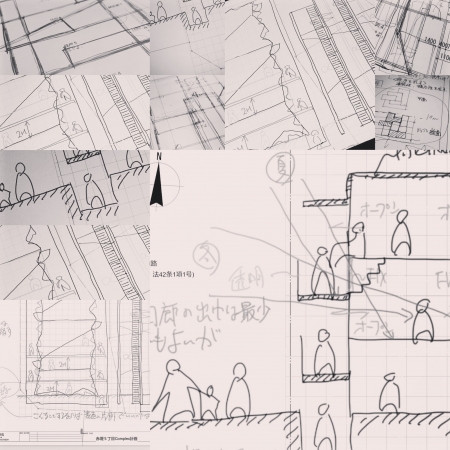関係性を空間に
ひとつひとつバラバラなものをそのままバラバラなままの状態で表すにはどうしたらよいか。
大きな容れ物の中に、ひとつひとつバラバラのまま、そのままの状態で納める。大きな容れ物が環境を守る役目をし、ひとつひとつバラバラなものの関係性は維持され、バラバラなままの状態で表すことができる。そして、大きな容れ物という、そのバラバラなままの状態で納める容れ物が、そのバラバラな状態を表す名称になる。
例えば、美術館や博物館がそうだろう。大きな美術館や博物館といった容れ物の中に、作品や展示物がバラバラなままの状態で納められ、ひとつひとつバラバラなものの関係性は維持され、バラバラなままの状態で表しており、その状態が、まさに美術館や博物館と呼ぶ。よくある手法だ。
他には、ひとつひとつバラバラなものを、ひとつひとつバラバラな関係性はそのまま維持して、別の事で新しく表すこと。この場合は、その関係性が、そのバラバラな状態を表す名称になる。
例えば、先程の美術館や博物館だとすると、ひとつひとつバラバラなものは、作品や展示物であり、その作品や展示物中から、あるいは、他の美術館や博物館から借りてきた作品や展示物を加えて、新たな関係性をくくり、展覧会をする。その展覧会の名称が、新たなにくくった関係性であり、それが「〜展」になる。
だから、ひとつひとつバラバラなものをそのままバラバラなままの状態で表す方法は、大まかに分けて2通りあり、1つは大きな容れ物を用意する、もう1つは新たなくくるための関係性を用意する。
前者は建築的な解釈にもなり親和性があるが、興味があるのは後者、言わば、関係性をデザインすることであり、それは建築以外でも役立つ手法であり、関係性を建築で実際の空間としてつくりたい。
"Relationships in space"
What should I do to represent things separately one by one as they are separately?
In a big container, put it as it is, one by one. Large containers serve to protect the environment, and the relationships of disjointed things are maintained and can be represented in disjointed states. And, the big container, the container which is stored in the broken state, is the name representing the broken state.
For example, museums and so on. Works and exhibits are stored in pieces in a large museum or museum space, and the relationship between pieces is kept one by one, and they are represented in a broken state, and that state is I call it a museum or a museum. It is a common technique.
The other thing is to keep things broken apart one by one, keep the broken relationships one by one, and express new things in another. In this case, the relationship is a name representing the disjointed state.
For example, in the case of the previous art museums and museums, things that fall apart one by one are works and exhibits, and by adding works and exhibits borrowed from those works and exhibits or borrowed from other art museums and museums, new items Hold a relationship and exhibit. The name of the exhibition is a new difficult relationship, which becomes "-exhibition".
Therefore, there are roughly two ways to represent things separately one by one as they are separately, one is to prepare a big container, the other is to prepare a new connection .
The former is also an architectural interpretation and has an affinity, but the latter is interesting, so to say, to design relationships, which is a useful method other than architecture, and to build relationships with actual space I want to make it.






























